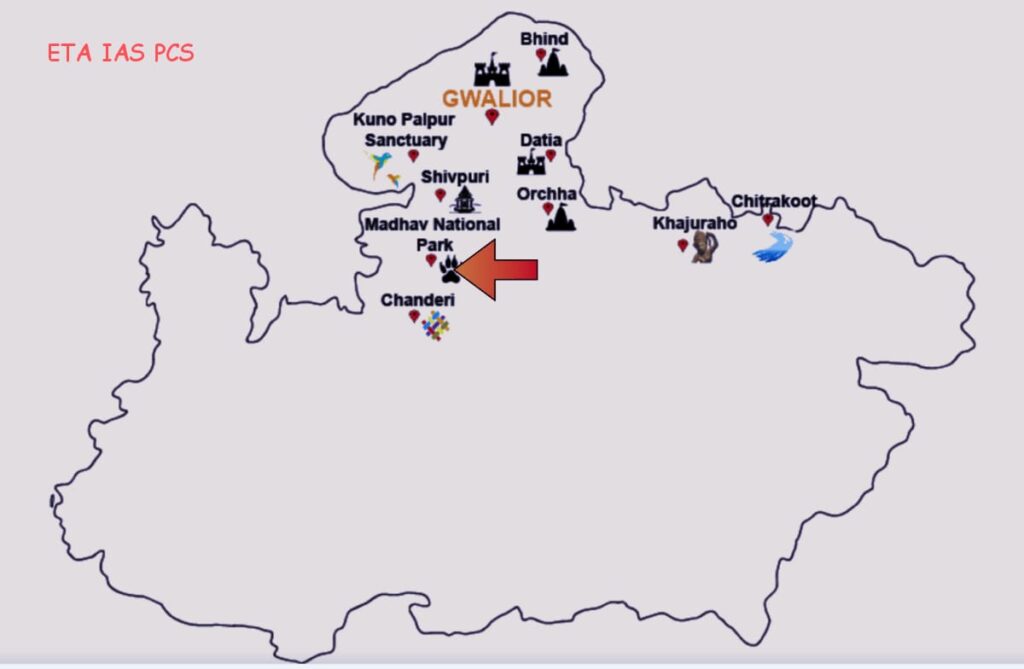Category
Date Posted
March 11, 2025
/
0 Comment
CONTEXT: India has designated the Madhav National Park in Madhya Pradesh as the nation’s 58th Tiger Reserve. This marks the ninth tiger reserve established in the state, following the creation of Kanha, Satpura, Bandhavgarh, Pench, Sanjay Dubri, Panna, Veerangana Durgavati, and Ratapani.

Madhav Tiger Reserve Overview
Location:
- Situated in Shivpuri District, Madhya Pradesh.
Geographical Characteristics:
- The reserve consists of diverse ecosystems:
- Dry deciduous forests
- Semi-evergreen forests
- Expansive grasslands
- Sakhya Sagar Reservoir:
- An artificial reservoir within the park.
- Recognized as a Ramsar site since 2022, emphasizing its importance for wetland conservation.
- The reserve consists of diverse ecosystems:
Notable Wildlife:
- The reserve boasts a rich diversity of fauna, including:
- Tigers
- Leopards
- Jackals
- Nilgai
- Sambar deer
- Wild boars
- The reserve boasts a rich diversity of fauna, including:
Historical Context:
- Renaming and Significance:
- Originally known as Shivpuri National Park, it was renamed Madhav National Park in honor of Madho Rao Scindia, the Maharaja of Gwalior from the Maratha Scindia dynasty.
- Royal Heritage:
- The park’s lush forests were once hunting grounds for Mughal emperors and Scindia rulers.
- George Castle:
- Constructed by the Scindias in preparation for a visit from British King George V in 1911.
- Reflects the region’s royal and historical significance.
- Renaming and Significance:

What are Tiger Reserves?
Definition:
- Tiger reserves are protected areas specifically designated to conserve tigers and their natural habitats.
Origins and Purpose:
- Established as part of Project Tiger, which was launched in 1973 by the Government of India to ensure the long-term survival of tigers.
Administration:
- Tiger reserves are managed by the National Tiger Conservation Authority (NTCA), which oversees their protection and conservation efforts.
Core/Buffer Strategy:
- The reserves are organized using a core/buffer strategy:
- Core Areas:
- These areas have the highest level of protection, often designated as National Parks or Sanctuaries, where human activity is minimal or prohibited.
- Buffer Areas:
- These surrounding areas are a mix of forest and non-forest land and are managed as multiple-use areas, allowing sustainable human activity while still focusing on conservation.
- Core Areas:
- The reserves are organized using a core/buffer strategy:
Who Notifies Tiger Reserves?
Notification Authority:
- Tiger Reserves are notified by State Governments as per the provisions of the Wildlife (Protection) Act, 1972, based on the advice of the National Tiger Conservation Authority (NTCA).
Steps Involved in Notification:
- Identification of Potential Areas:
- The State Government identifies areas that could potentially be designated as Tiger Reserves and submits a proposal to the NTCA.
- Review and Evaluation by NTCA:
- The NTCA thoroughly reviews the proposal, evaluating its feasibility and conservation potential.
- Recommendation by NTCA:
- After evaluation, NTCA recommends the proposal for the establishment of the Tiger Reserve.
- State Government Notification:
- The State Government officially notifies the area as a Tiger Reserve, thus securing its status for protection and conservation.
- Identification of Potential Areas:
Funding for Management:
- Once a Tiger Reserve is formed, the NTCA provides funds to support its management and conservation efforts.
Key Facts about Tigers
Umbrella Species:
- Tigers are considered an umbrella species, meaning their conservation automatically benefits a wide range of other flora, fauna, and entire ecosystems.
Global Population:
- India is home to 75% of the world’s tiger population, making it a crucial area for tiger conservation.
Tiger Census:
- The National Tiger Conservation Authority (NTCA) conducts a tiger census every 4 years to track the tiger population across India.
- As per the latest Tiger Census Report (2022), India has 3,682 tigers, an increase from 2,967 in 2018.
Top Tiger States in India:
- Madhya Pradesh has the highest tiger population in India with 785 tigers.
- Karnataka follows with 563 tigers, and Uttarakhand has 560 tigers.
Conservation Status:
- IUCN Red List: Endangered
- Wildlife Protection Act, 1972: Schedule 1
- CITES (Convention on International Trade in Endangered Species): Appendix 1
